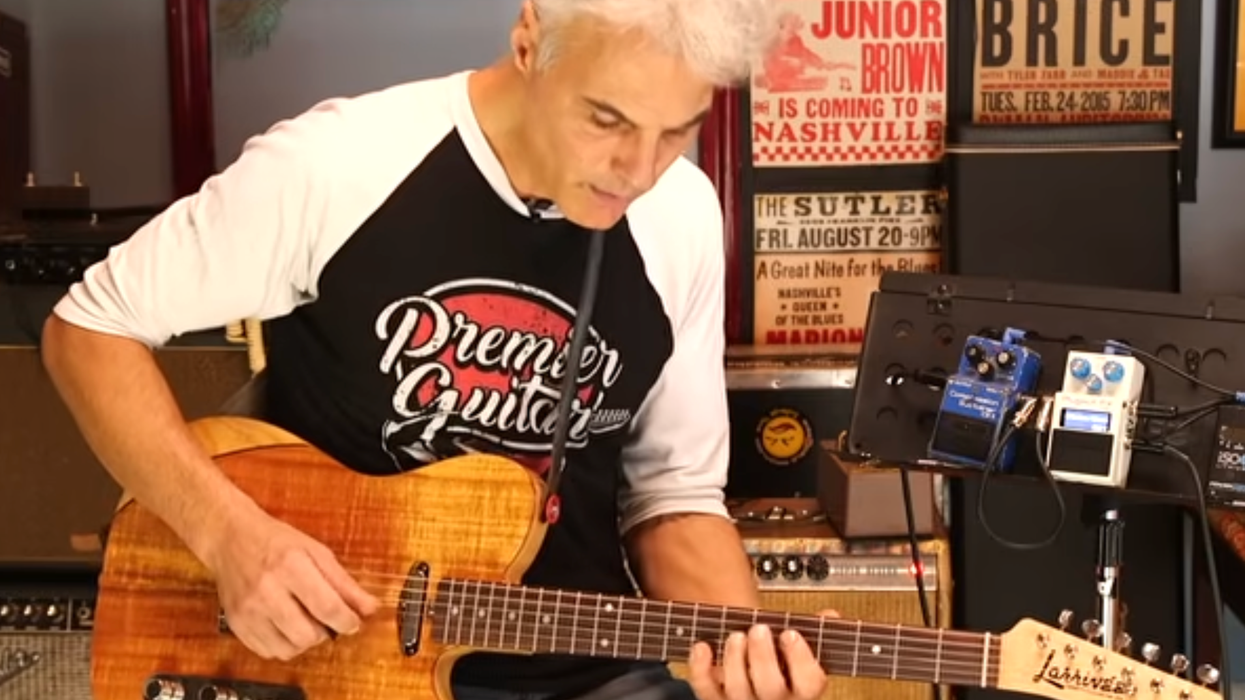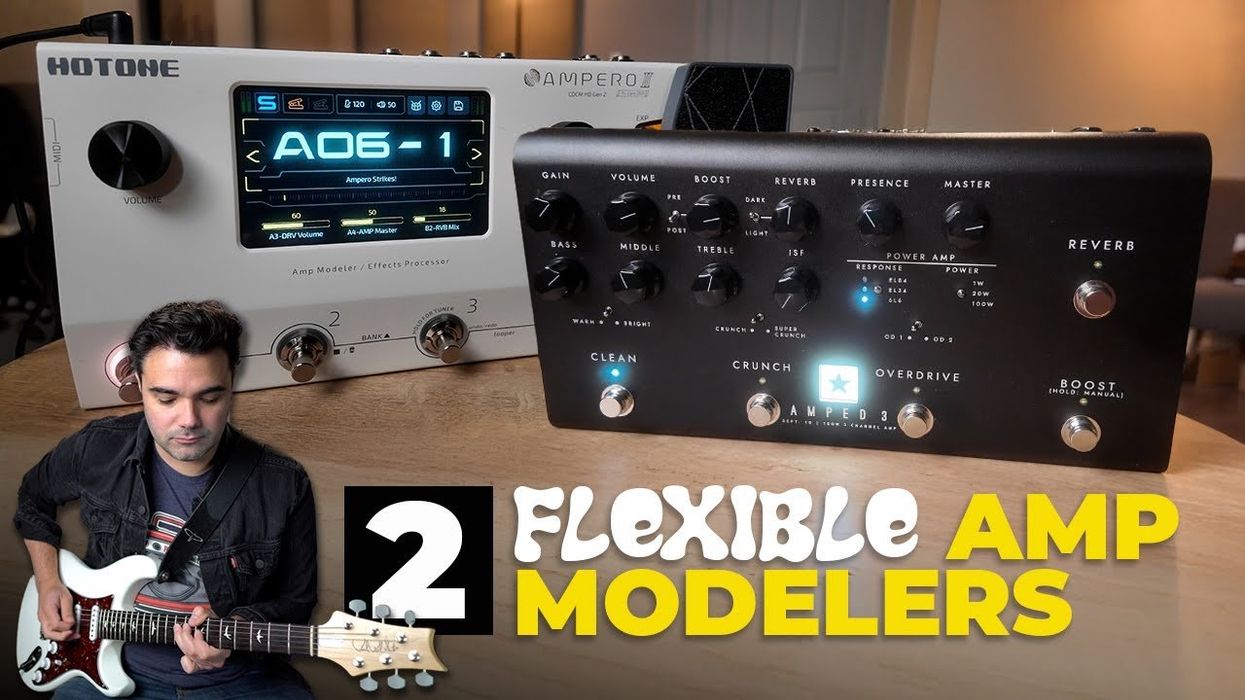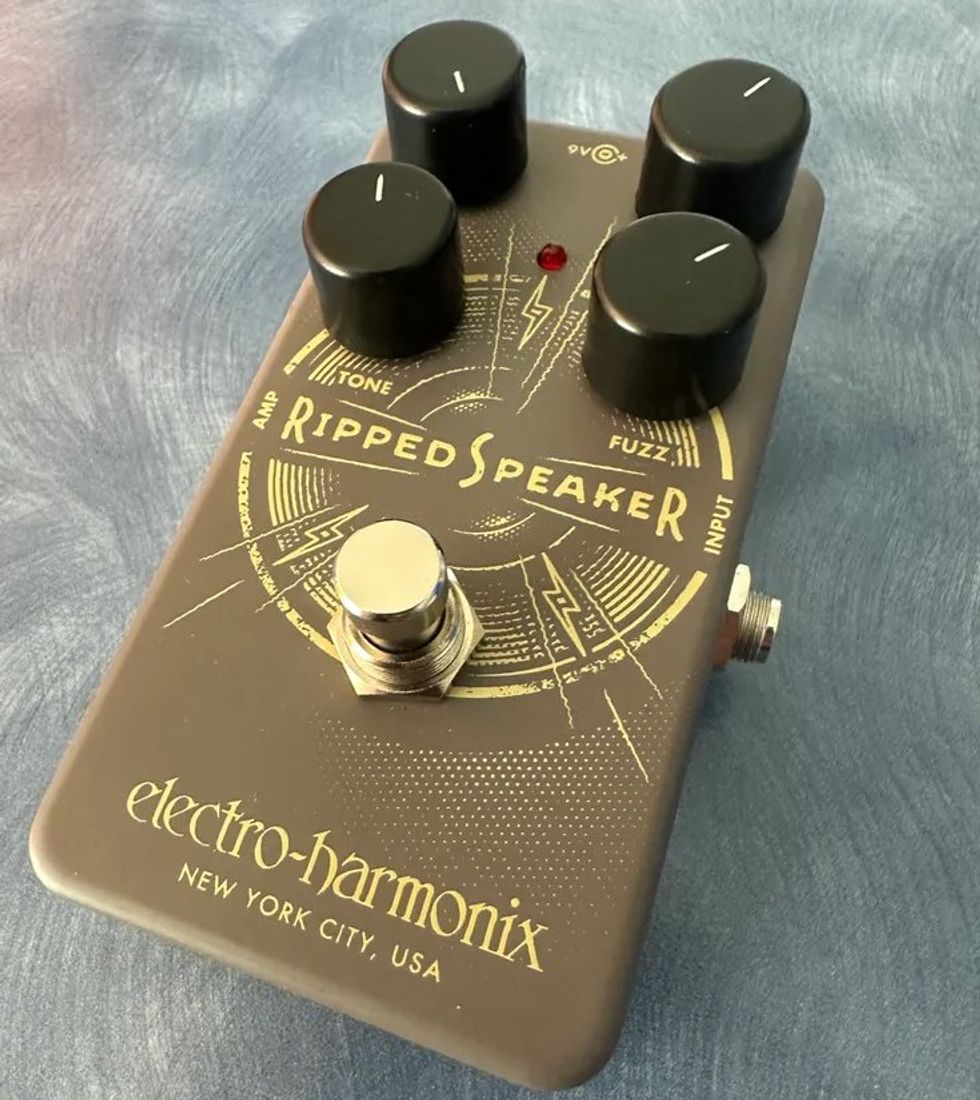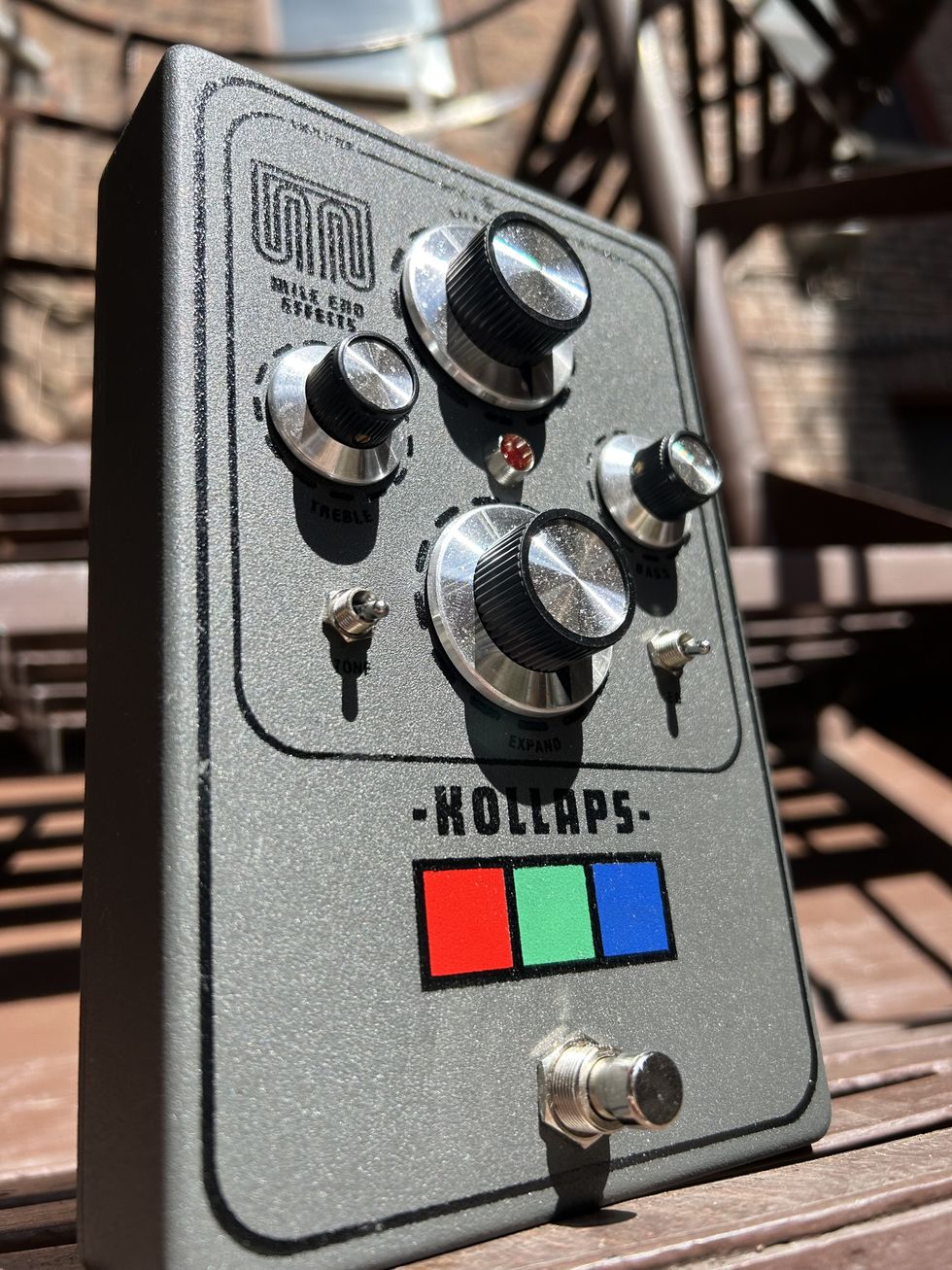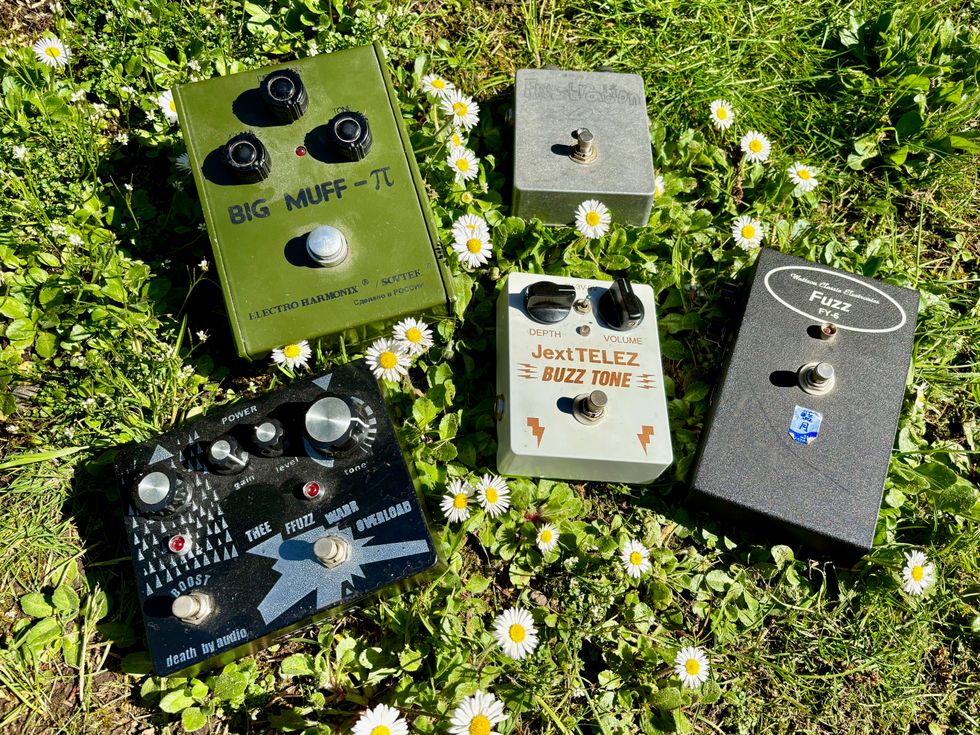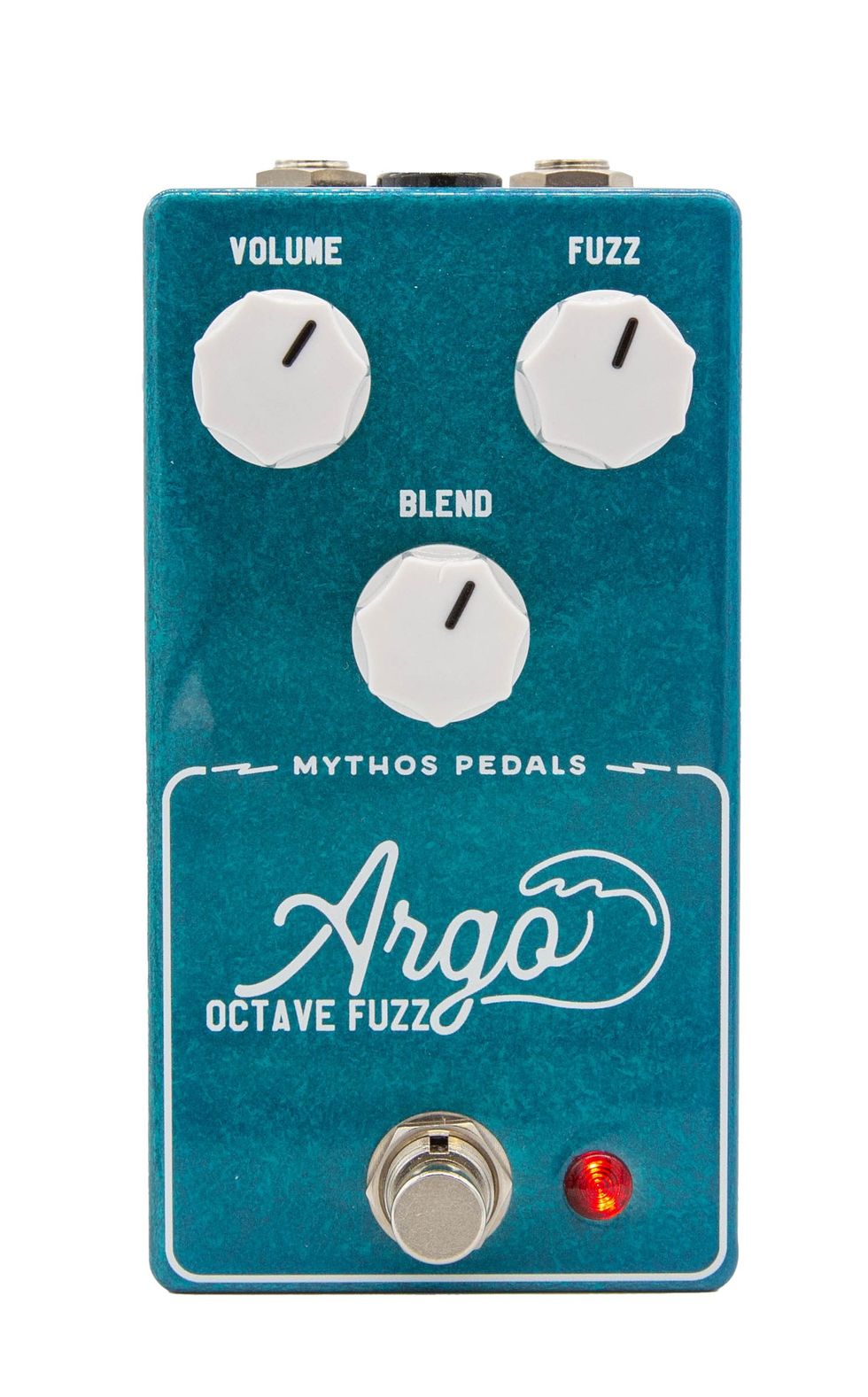Chops: Intermediate
Theory: Intermediate
Lesson Overview:
• Develop voicings that employ the 9 and 13.
• Create swing-inspired rhythm guitar parts.
• Learn how to combine the blues scale with the major pentatonic scale.
Click here to download a printable PDF of this lesson's notation.
In this lesson we’re going to dig into the uptown blues. What makes a blues uptown? The exact definition of uptown blues can be a bit nebulous. It’s not quite rural or “down home,” yet it’s not straight-ahead jazz—uptown blues lives in that musically gray area between blues and jazz. From a music theory standpoint, I’d describe uptown blues as having a harmonic sophistication, which is evident in the chords and solos of the great players of this style. The great T-Bone Walker was one of the key—if not the most important—players in this style, and in this lesson we’ll explore what he and others did in their solos and chord playing to achieve that uptown sound.
Chords and Rhythm
Before we jump to the cool licks, we need to take care of some business first—the business of playing rhythm. The rhythm player rarely gets the same amount of glory as the lead player, but a weak rhythm player can ruin an otherwise good band. Don’t be that guy or gal!
To play rhythm, you’ve got to know some chords, so that’s where we’ll start. One of the core things that separates uptown blues from other styles of blues is the harmony. In other blues styles, the prevailing harmony tends to be built with triads or dominant 7 chords. In Fig. 1 you can see a basic voicing for E and E7 and then we expand those to include the 9 and 13.
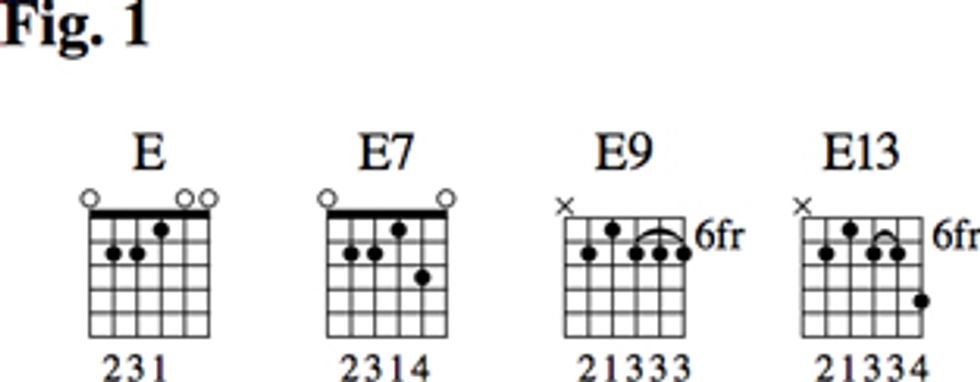
If this talk of 9s and 13s raises some concern, don’t fret (pun intended), they are easy to construct from basic chords that you’re probably already playing. Look at Table 1. In it, you’ll find the necessary formulas you’ll need to get started.
| Chord | Formula |
| Major | 1-3-5 |
| Dominant 7 | 1-3-5-b7 |
| Dominant 9 | 1-3-5-b7-9 |
| Dominant 13 | 1-3-5-b7-9-13 |
In Fig. 2 you can see that two adjustments are needed to turn a basic C chord into a C9 chord.
Step 1: To convert the C to C7, we drop the 5 and add the b7.
Step 2: To convert the C7 to C9 we replace the second instance of the root with the 9 (which is the same as the 2, but an octave higher).
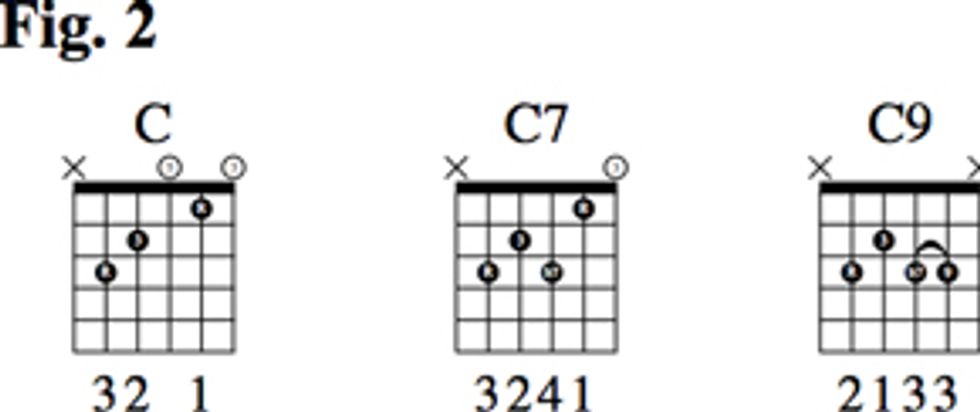
If you have never taken the time to learn what each of the notes are in the chord (i.e. the root, 3, 5, 7 and so on), I would encourage you to do that. Armed with this information and a few basic chord formulas, you can make the appropriate adjustments to create new chords from ones you already know.
Here’s how to arrive at a very useful 9th chord shape from your basic G major chord, shown in Fig. 3. First, we replace the open D on the 4th string with the F note on the 3rd fret, giving us the b7 needed to make a dominant 7 chord. We’ll also eliminate the 1st string and then play the 5 on the 2nd string instead of the 3. In the second step, we’ll substitute the 9 for the 3rd string root and skip the low root altogether. This is a common substitution, as the root doesn’t provide as much interest as the 9, and if you’re playing with a bass player, the root tends to be covered.
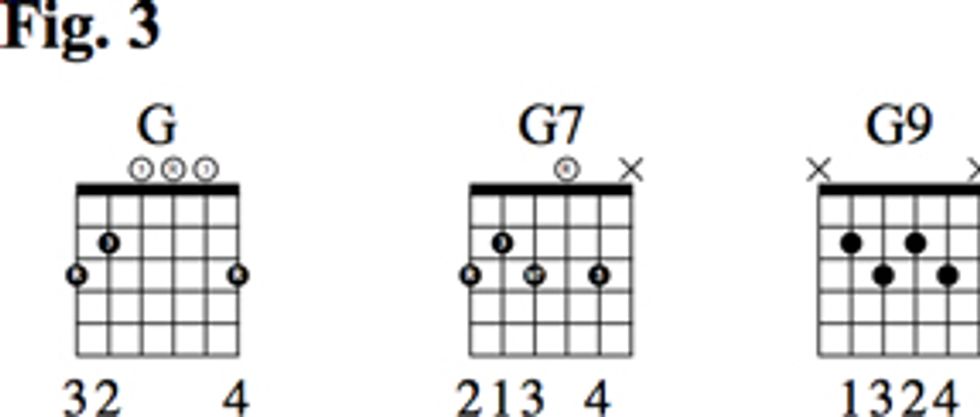
In Fig. 4, you’ll see how we can get to a hip voicing for a dominant 9 chord from our beloved major barre chord. We start with the basic shape at the third fret. From there, we drop the root on the 4th string two frets to get the b7. Then we add the 9 on the 1st string with our pinky. Now that all the notes are in place, we drop the root and 5 on the lower two strings to come up with a rootless voicing for G9. You could certainly play the barred version of the chord, but removing the bottom two notes gives more sonic separation from the bass player.
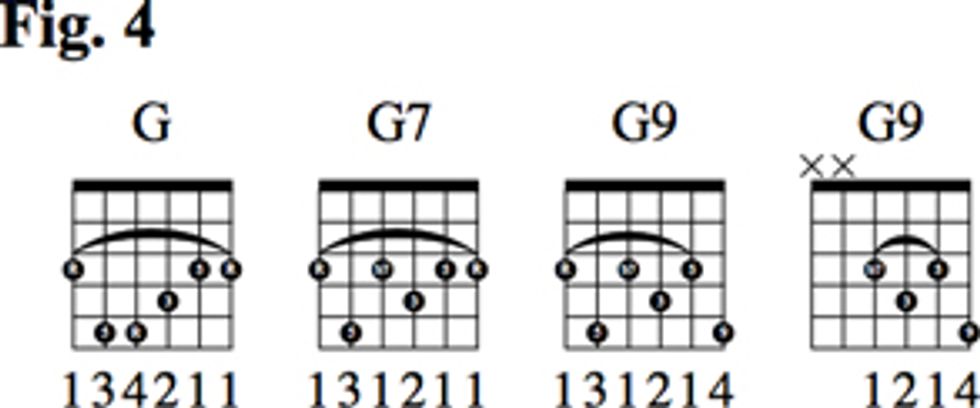
Now that we’ve got a few stock dominant 9 voicings in our hands, let’s expand them to the 13. If you recall from Table 1, the formula for the dominant 13 chord is 1 (or root)–3–5–b7–9–13. Some of you may be thinking, “What about the 11?” That’s a valid question. When building larger chords, the 11 can be included, and when it’s included on a dominant 7 chord, it tends to be a #11. However, for this lesson, we’re omitting the 11.
Let’s take our newfound C9 (from Fig. 2) and expand it to a dominant 13 chord in Fig. 5. We start with our original shape and then extend our 3rd finger to cover the G on the 1st string—that’s the 5th of the chord. Next, we replace that note by moving it up two frets and hit the A at the 5th fret with our pinky. Remember, the 13 is the same note as the 6, just up an octave. So by moving a whole-step up from the 5, we arrive at our 13.
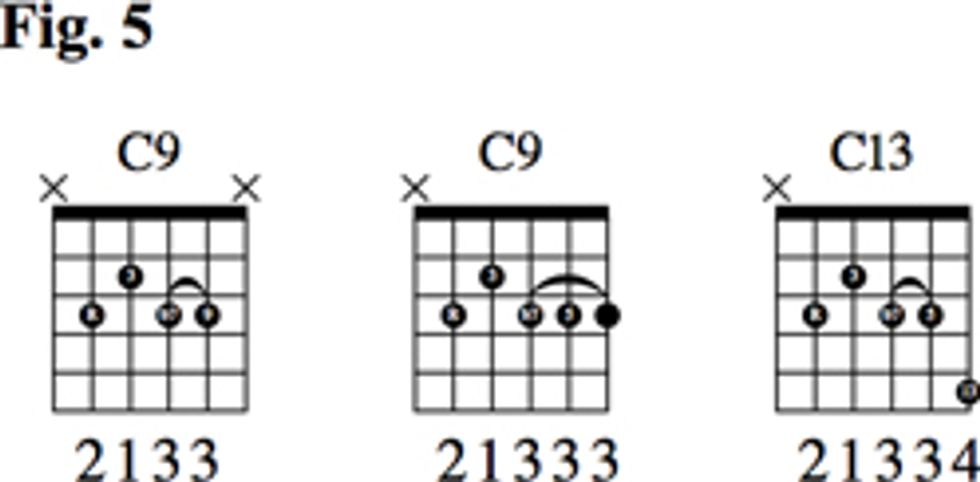
Let’s look at another option in Fig. 6. We start with the same C9 voicing as before, but this time we lower both the root (on the 5th string) and the 9 (on the 2nd string) down a whole-step.
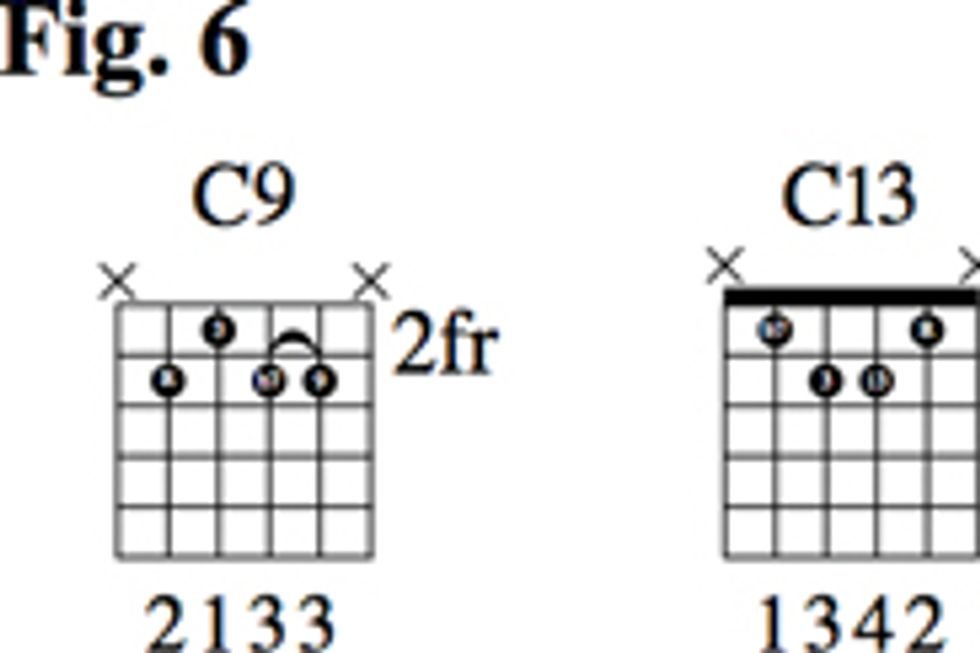
In Fig. 7, we’ll use the 13-for-5 substitution to arrive at our G13 voicing. Barre across the second fret with your first finger to allow your pinky to reach up for the 13 on the 2nd string.
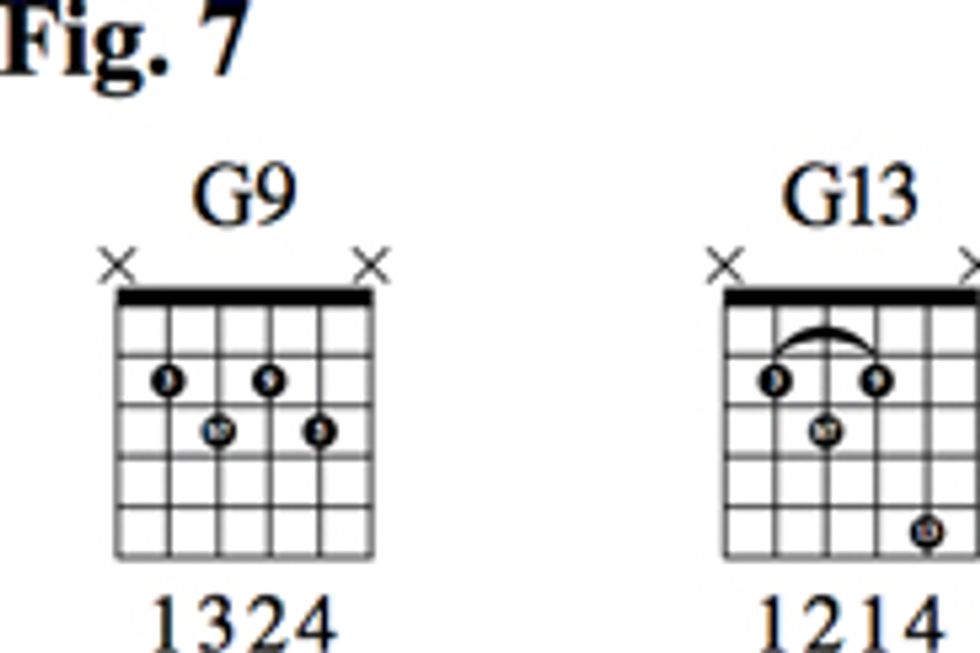
Once again in Fig. 8, we’ll use the 13-for-5 substitution to arrive at a G13. You can decide whether or not to include the 9 in this 13th voicing.
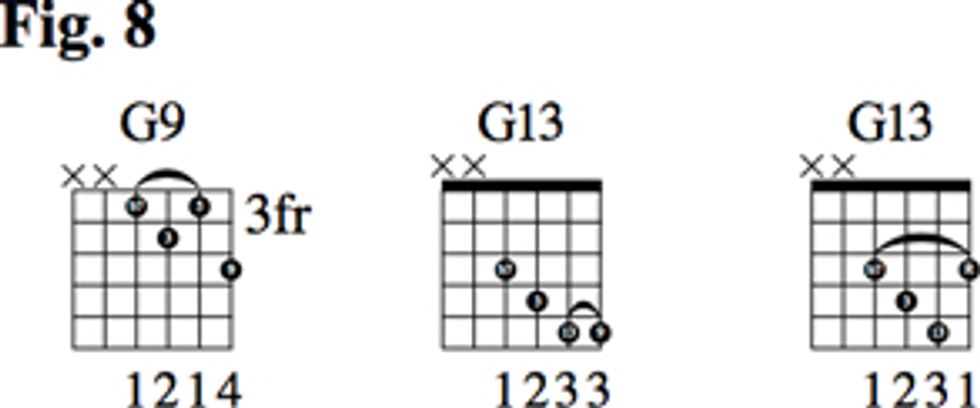
Let’s add some rhythm to these chords. The first rhythm accompaniment pattern we’ll look at is referred to as “four to the bar,” shown in Fig. 9. Keep the quarter-note pulse throughout the progression while emphasizing beats 2 and 4. This feel is common to swing and jazz. Freddie Green was a master at this feel. Check out recordings of him with Count Basie.

Another common chord move is to approach your target chord from a half-step above or a half-step below, as you can see in Fig. 10.

For these next examples, think about the sound of a horn section. Horn sections are often a part of bands that have an uptown sound. With 9th and 13th voicings you can imitate the sound of a horn section; Fig. 11 and Fig. 12 present a few rhythms used to convey that sound.
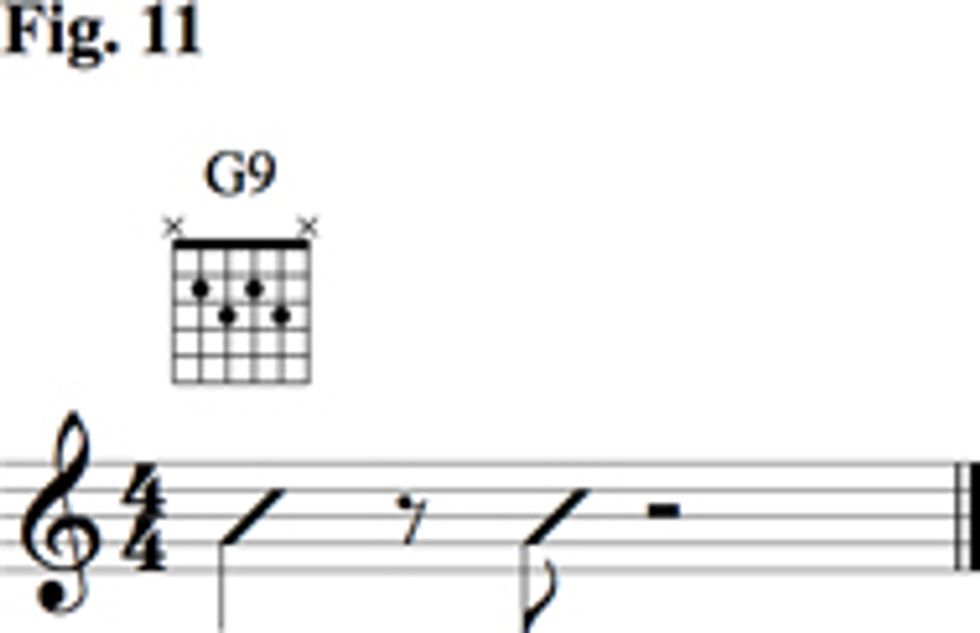

Now we’ll put all of this together in Fig. 13. By utilizing multiple voicings of the 9th and 13th chords—and moving them around by either a half- or whole-step and applying various rhythms commonly found in swing and jazz music—we’re able to create a sophisticated accompaniment to the basic blues progression.
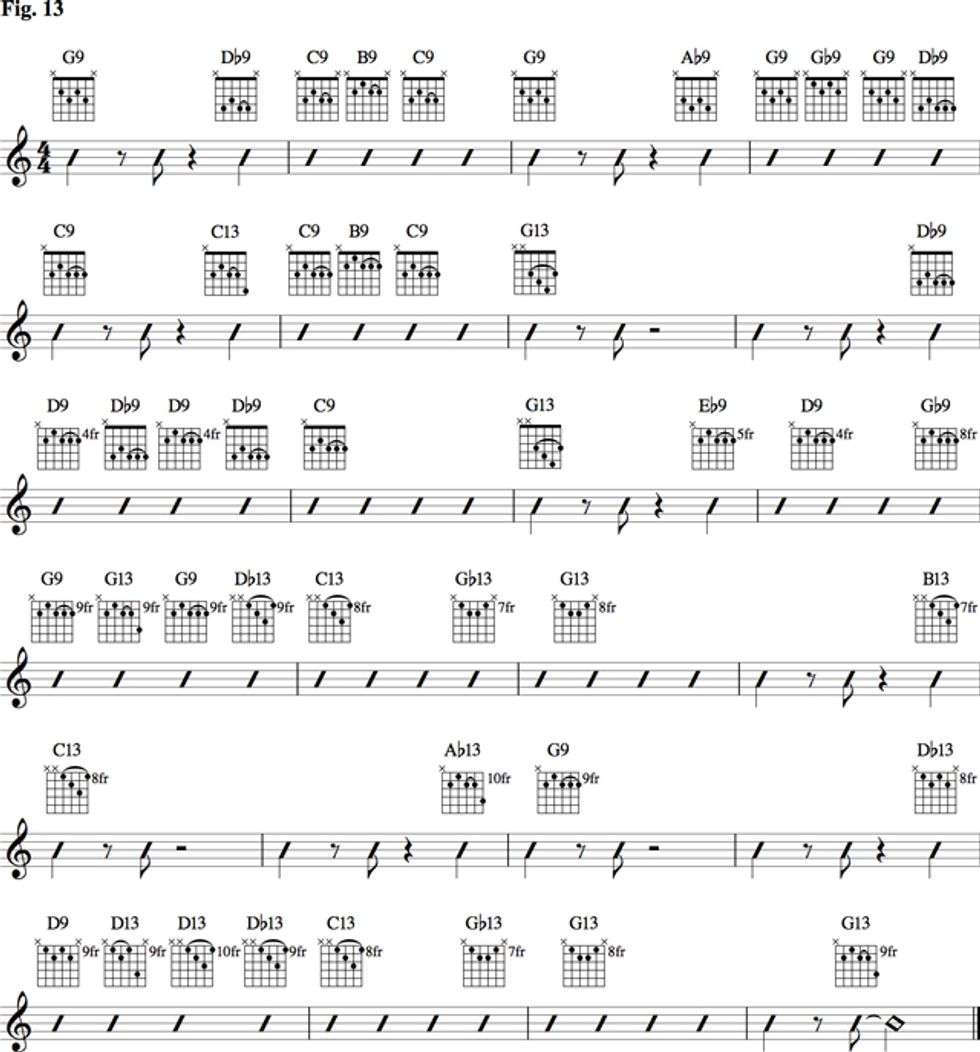
Watch the following video clip of Duke Robillard and Chris Flory. You get a chance to hear a superb solo backed by wonderful chords.
The final accompaniment strategy we’ll explore is a technique often referred to as the “sliding 9th.” If we take the 9th chords in Fig. 14 and slide the top three strings of each voicing up a whole-step, the chord becomes a 6th chord. Remember, the 6 is the same as the 13. This move is very effective in adding harmonic color to your accompaniment. Fig. 15 demonstrates this technique over the first four measures of a blues progression.
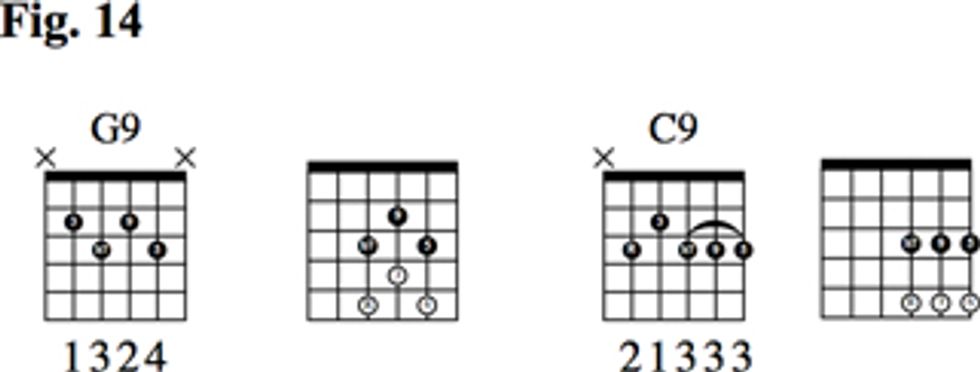

This move is effective at medium and fast tempos, however, it really comes alive over a slow blues. Check out the following clip to hear Johnny Moore utilizing this technique over the classic “Driftin’ Blues.”
Soloing
Many of you are probably quite comfortable soloing over the blues with the tried-and-true blues scale, and if you’re concerned that the extended harmony we’ve introduced will force you to change your approach to soloing over the blues, have no fear because the blues scale still works. Having said that, blanketing the blues scale over the accompaniment found in Fig. 13 won’t quiet capture that uptown sound.
Players such as T-Bone, Johnny Moore (who played with Charles Brown), and Tiny Grimes had a knack for highlighting the interesting notes of the chord at the appropriate time—getting inside the chord. The blues scale doesn’t have all the notes needed to pull this off. For example, say we’re playing an uptown blues in G using the G blues scale (G–Bb–C–Db–D–F) over a G9 (G–B–D–F–A) chord. You can see in Fig. 16 that the scale doesn’t include the 3 or the 9 of the chord—two very useful sounds.
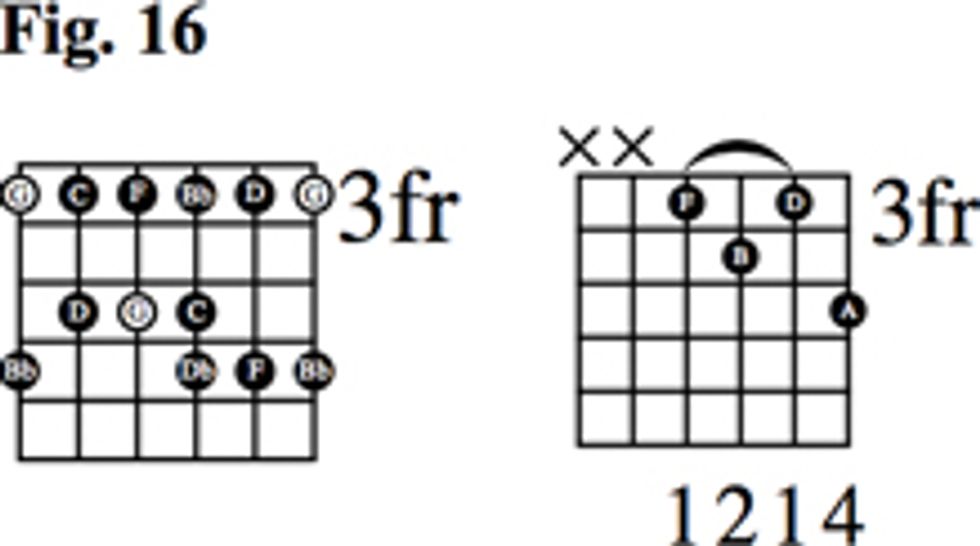
How do we solve this problem? One way is to use the major pentatonic scale. See Fig. 17 for the comparison of the scale and the chord. The major pentatonic gives us the 3 and 9, which the blues scale doesn’t. However, the major pentatonic scale does not include the b7, which is also an important tone.
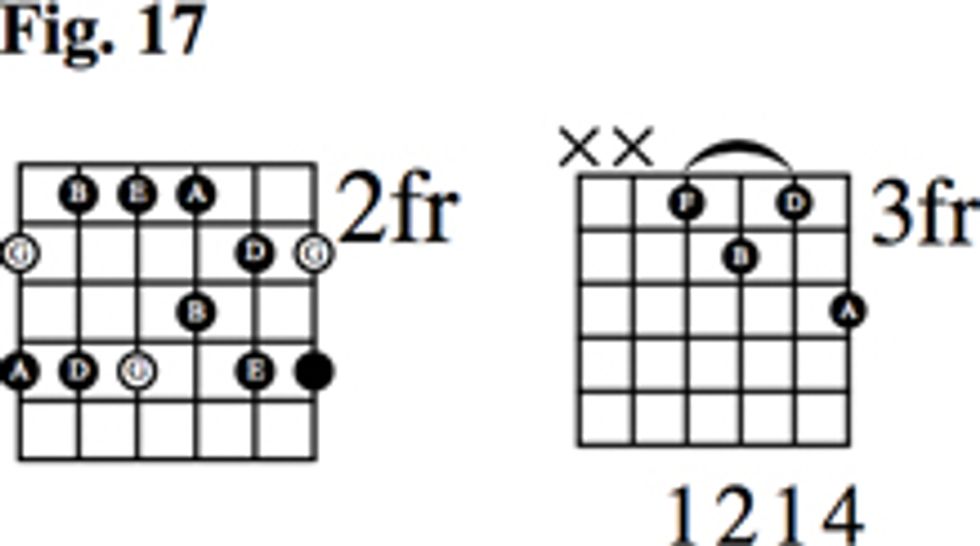
So which scale should you choose? Why choose? Use both! One of the goals is to convey the sound of the chord, and by using both scales you have the tools to do this. Do both scales give you all the notes of each chord in the progression? Look at Table 2. Here I’ve spelled out the notes of each chord—up to the 13—along with the blues and major pentatonic scales for a blues in G.
| Chord or Scale | Notes |
| G13 | G-B-D-F-A-E |
| C13 | G-E-G-Bb-D-A |
| D13 | D-F#-A-C-E-B |
| G Blues Scale | G-Bb-C-Db-D-F |
| G Major Pentatonic | G-A-B-D-E |
If you look closely, you’ll find that the combination of the blues scale and major pentatonic scale does not give you every note found in every chord. The 3 of the D13 chord, F#, is not found in either scale. To convey the sound of the complete V chord (D13), you’ll need to incorporate the F# into your solos.
This discussion is not meant to complicate the issue of soloing over the blues. My hope is to shed some light on why blanketing the blues scale over the progression may not yield an uptown flavor to your solos. A great way to incorporate these sounds into your solos, without thinking about which scale will give you a specific sound at a specific time, is to play out of the chord shapes we’ve discussed thus far. The first three licks we’re going to dig into come out of the G9 chord shape we used in Fig. 17.
For example, if you want to integrate the 9 (A) into your phrases, you can try out Fig. 18.

Try the following Charlie Christian lick if you want to add the sound of the 9 and the 13 (E).

Charlie Christian may not be the first person that comes to mind when discussing the blues, but his playing influenced countless electric blues pioneers. If you want to venture into the jazzy side of the blues, spend time listening to him. Check out the following YouTube video of Christian playing “Seven Come Eleven.” It’s not a blues, but his solo is full of licks that can be used over the blues.
Fig. 20 was played by Tiny Grimes on “Tiny’s Tempo” recorded with the great saxophonist Charlie Parker. The lick begins at about 2:24 in the video below, but I have transposed it to the key of G to work over the G9 chord.

The phrase in Fig. 21 incorporates chord hits, half-step chord moves, and adds the sound of the 9 over the G13 chord. It can be used as a turnaround at the end of the blues form.

The final two licks are based out of the C9 shape in Fig. 14. Fig. 22 is a Charlie Christian lick from the “Seven Come Eleven” recording mentioned earlier and includes the 9 and 13. I transposed it to C to fit over the chord.

The final phrase (Fig. 23), literally spells out the notes of C9, starting on the 3.
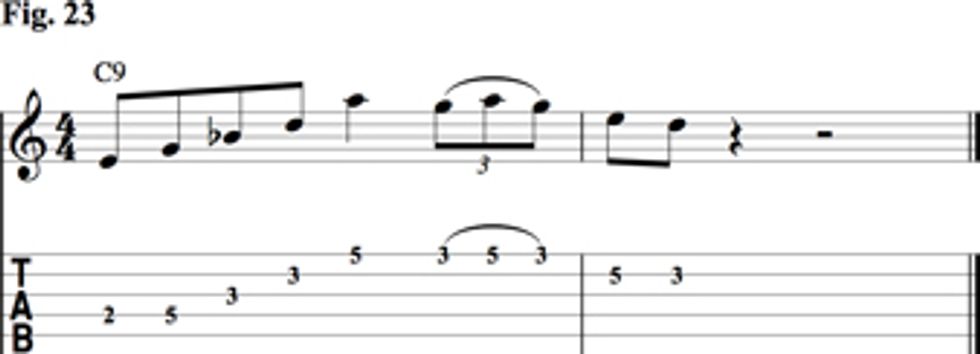
Closing
We’ve covered a lot of territory in this lesson. If the theory seems a bit overwhelming, don’t worry. Take your time digesting it and find a teacher or a friend to help you out. You don’t need to know all the theory to play this material. In fact, one of the best ways to learn it is to spend time with recordings, learning licks and absorbing the feel of this style. Before long, you’ll feel as comfortable with adding 9s and 13s to your chords and solos as you do rocking out with the blues scale over a Jimmy Reed shuffle! It just takes time, but what better way to spend your time than practicing your guitar and listening to great music. Good luck!
Recommended Listening
T-Bone Walker: He’s been mentioned several times in this article already and is one of the key players in this style of blues. I’d recommend checking out The Complete Imperial Recordings: 1950-1954, it’s all great stuff. Right from the start with “Glamour Girl,” you hear his trademark licks and chord moves.
Charlie Christian: Influential to not just blues players but swing, bebop, and—by way of America’s musical family tree—rock players as well. The Genius of Electric Guitar is great. A few blues tracks to check out are “Gone With ‘What’ Wind,” and “Grand Slam.” Also worth a listen is The Immortal Charlie Christian. Here he performs with some of the founding fathers of bebop. Check out the track “Blue N’ Boogie.”
Johnny Moore: Take a listen to “Johnny’s Guitar Blues” from The Very Best of Johnny Moore’s Three Blazers. On it you’ll also hear the great pianist and band member Charles Brown. This set includes classics like “Driftin’ Blues” and “Merry Christmas Baby.”
Charlie Parker (with Tiny Grimes): I mentioned that uptown blues falls into that gray area between blues and jazz, so it’s not surprising to find jazzy blues players with bebop musicians. Here, Tiny is with alto sax player Charlie Parker on Parker’s The Savoy and Dial Master Takes. Take a listen to “Tiny’s Tempo.”
Tiny Grimes: With a title like Blues Groove, you’re sure to find some blues. Here Tiny is tearin’ it up with more jazz greats.
Duke Robillard: Duke is a contemporary player and an incredibly versatile guitarist who can lay down the blues and swing hard. He’s made many albums that showcase his ability to play the uptown blues with authority. On After Hours Swing Session, you can hear his take on “Tiny’s Tempo.” Another record worth listening to is Swing. Don’t let the title fool you—six of the 12 tracks are blues tunes.
Duke Robillard and Herb Ellis: Duke also made two recordings with the late, great jazz guitarist Herb Ellis and I recommend them both. They are Conversations in Swing Guitar, and the aptly titled More Conversations in Swing Guitar. As I stated earlier, regarding Duke’s record, Swing, don’t let the title of these collaborations throw you, there’s an awful lot of blues on these recordings as well.
 Mike Cramer is an award-winning performer and educator. A stylistically versatile multi-instrumentalist, Cramer has shared the stage with or opened for B.B. King, Tommy Castro, Chris Duarte, Gordon Goodwin, John Hartford, and Steve Kaufman. Cramer co-founded All 12 Notes, LLC where he has a private lesson studio, teaching guitar, mandolin, and electric bass. His most recent CD release, Open Spaces, is a collection of original and traditional acoustic pieces. For more information, visit all12notes.com.
Mike Cramer is an award-winning performer and educator. A stylistically versatile multi-instrumentalist, Cramer has shared the stage with or opened for B.B. King, Tommy Castro, Chris Duarte, Gordon Goodwin, John Hartford, and Steve Kaufman. Cramer co-founded All 12 Notes, LLC where he has a private lesson studio, teaching guitar, mandolin, and electric bass. His most recent CD release, Open Spaces, is a collection of original and traditional acoustic pieces. For more information, visit all12notes.com.



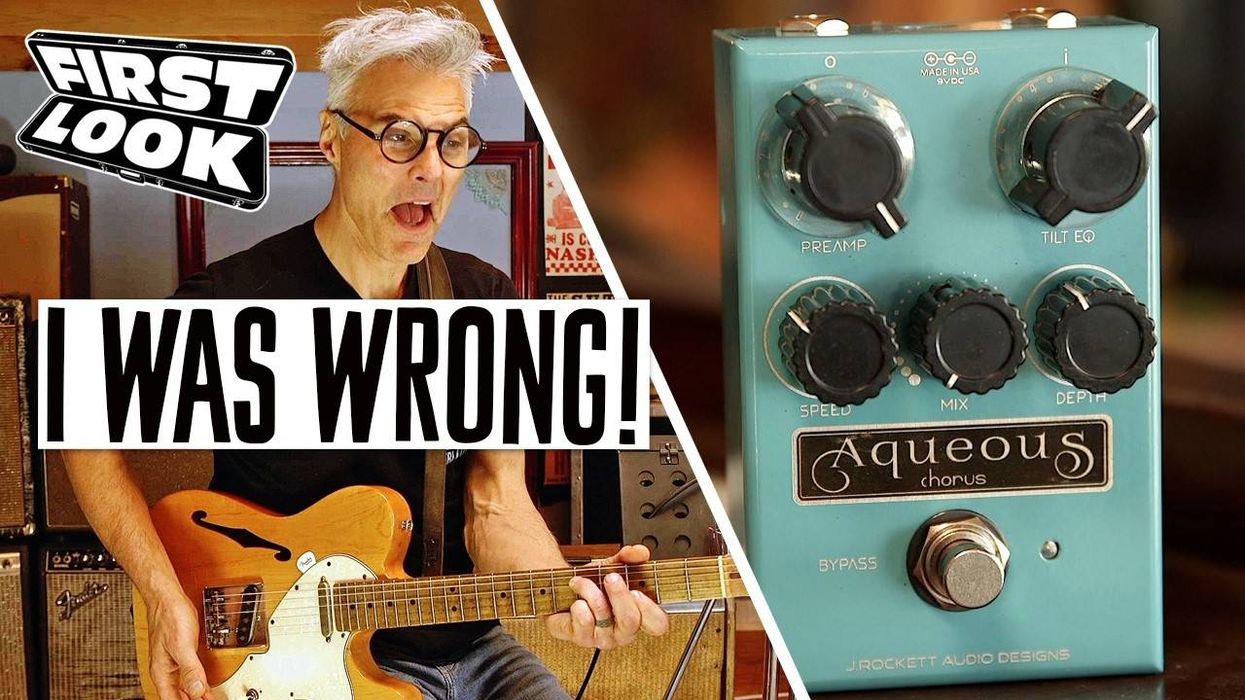


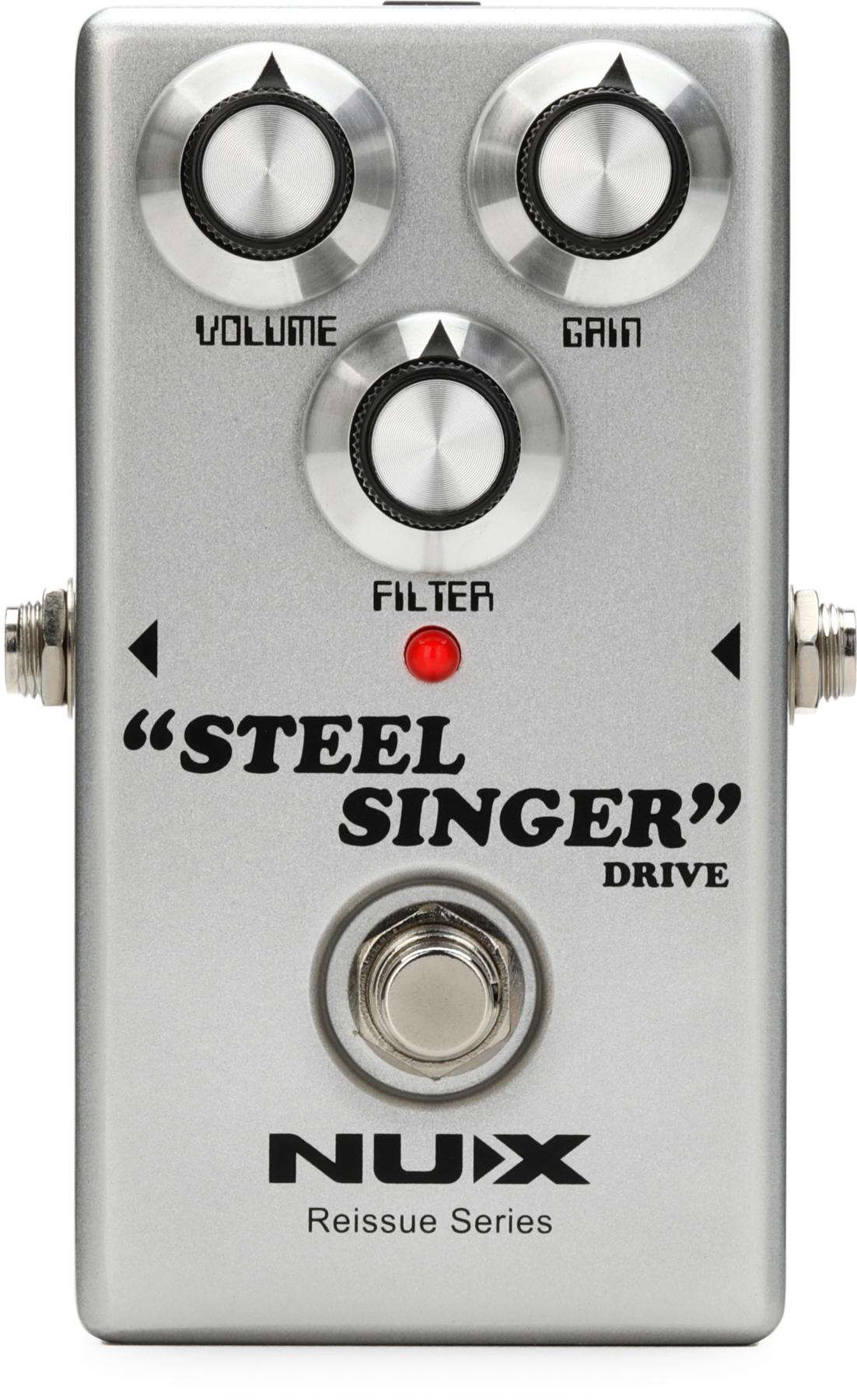



![Rig Rundown: Russian Circles’ Mike Sullivan [2025]](https://www.premierguitar.com/media-library/youtube.jpg?id=62303631&width=1245&height=700&quality=70&coordinates=0%2C0%2C0%2C0)

